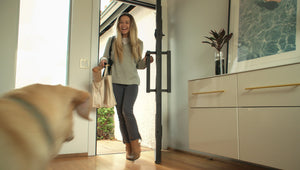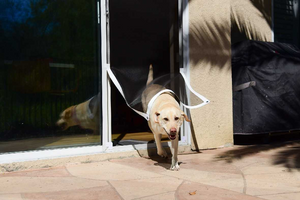How to Keep Your Dog in the Yard
When it comes to maintaining our dogs’ happiness, one of the most prominent considerations for dog owners is their freedom. We want them to have a range of activities in which to get plenty of exercise and space to roam while simultaneously keeping them safe from harm and making sure that they are not inflicting on our neighbors.

So what’s the solution? Generally, it depends on the setup of your yard and the way your dogs escapes. If your yard is not blocked off with a physical fence, boundary training is the most reliable solution. If you are not comfortable trusting your pooch to stay in an area that is not enclosed, installing an invisible fence is a reliable alternative. For dogs that manage to escape in a yard that is already fenced, such as with a wall or a chain link fence, there are multiple ways to address the situation and prevent future attempts to leave the yard.
For Yards without Fences: Boundary Training
Whether you have property or live in a neighborhood that prohibits fencing, boundary training is the simplest method for ensuring that your dog stays in the yard. With proper, diligent training (and the help of a dog trainer), this can usually be mastered within a few weeks. However, the more training, the better the results. This training requires a clicker.
Start by purchasing marker flags from the local hardware store. These will serve as both boundary markers and your dog’s incentive to return to you. Start in a safe place indoors, showing your dog one of the marker flags. Let your dog touch their nose to the flag. As soon as the flag is sniffed, press the clicker and immediately reward your dog with a treat—preferably one that is of high value, such as a piece of chicken or cheese. Practice this several times a day for a few days to a week, placing the flag at a further distance each time. This helps your dog associate the flags with reward, because every time he touches the flag, he receives a treat. Always make sure to reinforce their good behavior with the clicker and treat. Make sure to not reward bad behavior, as this will make training harder.
Once the indoor flag practice has been mastered, you can move the training outdoors. To start, make your boundary line with the flags, leaving an 8 ‒ 10 foot space between each one. With your dog on a long leash, preferably a retractable one that allows about 15 ‒ 20 feet of leeway, direct him to touch the flag. Immediately click and reward for each flag touched. This conditions your dog to return to you after touching the flag. With enough practice, this will become second nature.
Once your dog starts consistently returning to you, increase the length of the boundary and repeat the process. Make sure to continue using the leash and the best dog treat rewards. This time, include low level distractions, such as adding a friend, family member, or another pet to the situation. Incorporating another layer of complexity to the training will help your dog realize that touching the flag and returning to you is worth more than pursuing distractions in fun environments.
When you feel confident in your dog’s ability, remove the leash. Make sure to provide a hefty amount of clicker and treat action to reinforce diligent behavior. This last portion of training may take longer to master for all dog breeds, so make sure you are 100% confident in your dog’s ability to remain in the yard prior to leaving him unattended. If your dog does happen to dart off, do not punish him. This is one of the most prominent training mistakes to avoid, as negative reinforcement does not lead to positive training results! Be patient with your pet and practice often.
For Yards with Fences: The Jumpers/Climbers, Diggers, and Patrollers
Jumpers & Climbers
For dogs who have mastered the art of leaping and climbing over the fence that is intended to keep them from doing so, there are a couple ways to solve this issue.
- The Oscillot: This is a rotating paddle (also known as coyote rollers) that installs on the top of your existing dog fence. When your dog tries to climb over the fence, the paddle rotates toward him, causing him to fall back into the yard. It creates the illusion that he can still climb out, but once he reaches it, there is no way to successfully get over the fence. This is also helpful for keeping coyotes or neighboring cats out of your yard.
- Overhead Netting: The overhead netting installs on the top of your existing fence, resting at a 45° inward angle. This prevents dogs from being able to jump or climb over the top of the fence. Once your dog realizes that the netting prohibits their ability to jump or climb over, he will refrain from attempting to escape.
- Landscaping: Although this may seem like a solution that is too good to be true, landscaping a wide and tall enough area along the fence with thick shrubbery can be enough to prevent a dog from jumping or climbing. The shrubbery not only serves as a barrier, but also improves the aesthetic quality of your yard!
Diggers
For dogs who will stop at nothing to burrow under your fence, there are two simple solutions that will prevent you from needing to continually re-landscape your yard.
- Chicken Wire: Although it is not the most attractive solution, chicken wire is an easy, cost efficient way to prevent digging. You can either install it at the base of the fence or even bury it underneath the dirt or grass at the foot of the fence to block your dog’s digging access. It can be purchased at your local hardware store.
- Concrete Footer: Another solution is pouring concrete along the base of your fence. For best results, make sure that the bottom of the fence is submerged in the concrete to stop even the most persistent diggers!
Patrollers
If your dog adamantly patrols the yard, protecting against what he considers mayhem, and then does everything in his power to guard the premises from outside of the yard, it is necessary to block his view of the proceeding area as a preliminary measure. Limited visibility will reduce your dog’s urge to get out.
- Fill in the spaces between fence posts: Bamboo rolls or reed fencing are viable solutions to filling in the gaps between each individual fence post. This relatively inexpensive process only requires zip ties to install.
- If you are worried about the aesthetics of your yard, opaque fencing is another solution. However, it does require removing the current fence and replacing it with a newly purchased one.
A Few Other Useful Tips
- Make sure your yard is a happy place for your dog. Provide an ample amount of toys, fresh water, and shade. If your space is not a comfortable size to stay in all day, it is recommended to install a reliable pet door, whether for doors or for sliding glass doors, to give your dog the freedom to go in and out at their own will.
-
Don’t leave your dog alone for long periods of time if you don’t have to. Being alone is more of a motivation for them to leave the yard, because they are more likely to want to interact with people or other dogs. This can also be a symptom of separation anxiety.
- Make sure that all gates are locked before you leave your dog unattended.





Hi Angie,
I’m very sorry to hear about the loss of your poodle and that your little guy is experiencing some anxiety.
I would recommend checking out this article we have on reducing separation anxiety for pets: https://www.petdoors.com/blogs/dog/help-your-pet-cope-with-separation-anxiety.
If you have any other questions, please feel free to call us at 1-800-826-2871 or email customerservice@petdoors.com.
Happy New Year!
Our little Monster (daddy was Chihuahua-Corgi, mother was schitzu) suffers from anxiety. We recently lost our poodle that was his companion. Since then we can’t leave him alone. He dug through heavy gravel and went under the chain link fence to get out. Luckily we found him running down the road. He is chipped and has a collar with his tags and our phone number and he always comes back home, but we now take him everywhere with us. I’d love to be able to run to the grocery store or doctor and leave him either inside or out, but he just goes crazy! It makes me feel so bad. We’ve been unable to find a suitable companion being that we live in a small rural community, but we are still looking. Until then, Amy suggestions? Thank you in advance.